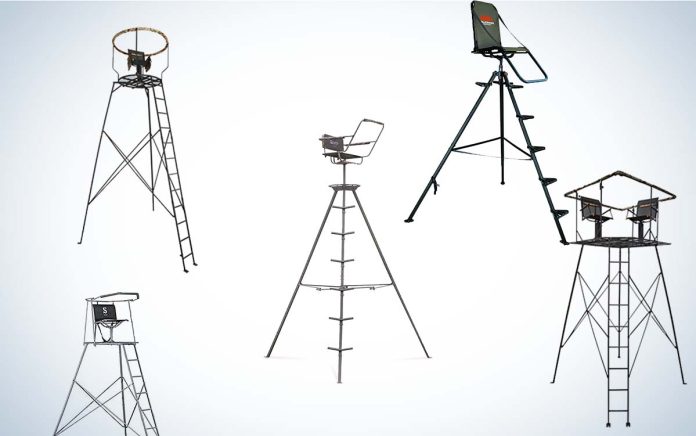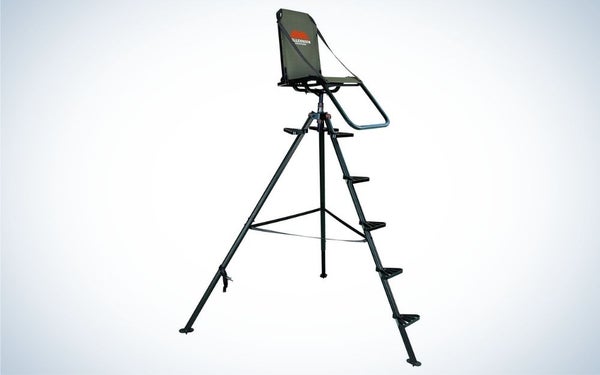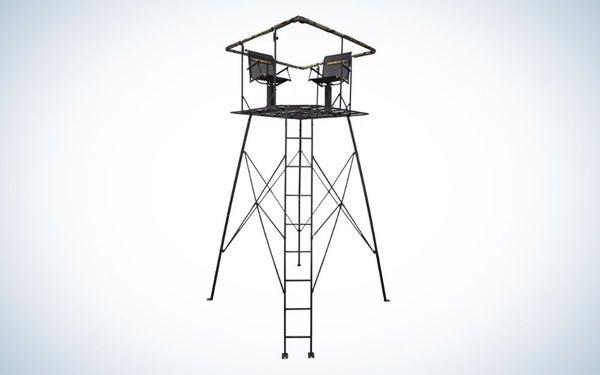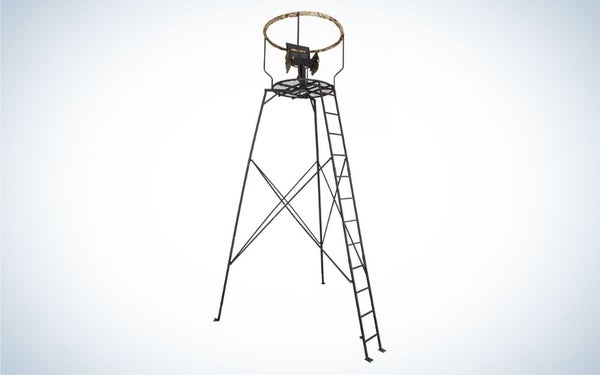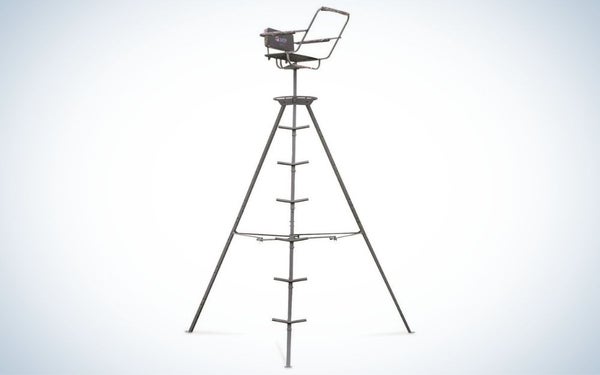We may earn revenue from the products available on this page and participate in affiliate programs. Learn more ›
Updated Jul 31, 2023 11:53 AM
Tripod deer stands feature three steel or aluminum legs that create a broad base leading to a narrow top where the seat is attached. They give hunters an elevated view, so many prefer them over ground blinds where sight is restricted by vegetation or the landscape. A feeder is often placed nearby, allowing hunters to chase deer and other critters from virtually any location. That’s the great thing about a tripod—put it up where you want it, stick it in some cover, and hunt where the game is.
Many tripods are constructed from ultra-light materials that make transport and setup a breeze, while others are made with steel and meant to be left in one location for years. Some are fitted with La-Z-Boy-like seats and promise season after season of use. Many are between 10 and 12 feet tall. Here are some of the best tripod deer stands on the market so you can get in on the action.
How We Picked the Best Tripod Deer Stands
Living out West, I will admit my tripod use is somewhat limited. However, each tripod mentioned in this article has been tested by yours truly or recommended by a whitetail fanatic.
There was a time when there were only four or five tripod stands on the market, limiting a hunter’s options. Today, many treestand makers offer at least one tripod. Some of the features most considered were durability, safety, comfort, ease of construction, and height and weight. Seats that swiveled were tested for noise, and I will note that tripods left out in the elements for years sounded like a rusty gate when the climbing system was used or when one’s butt shifted even slightly in the seat. Tripods that were cared for performed as advertised.
The Best Tripod Deer Stands: Reviews & Recommendations
Best Portable: Millennium T-100 10 ft Aluminum Tripod
Specs
- 36 pounds
- 10 ft. high
- Comfortable
Pros
- Height
- Lightweight and durable
- Swivel seat
- Fast setup
Cons
- No shooting rest addition
- Small platform
- Pricey
Millennium designed the T-100 for those demanding a lightweight, easy-to-set-up model that will last for many seasons. I’ve used this easy-to-construct tripod for years, and you can’t beat its comfort and 360-degree swivel seat. The total stand weight is 36 pounds, and the setup time, if you read the owner’s manual, is less than a minute. The 10-foot height is perfect for backing the stand into the brush so the hunter can disappear in a vegetated backdrop. The four-foot extension is handy for those areas where cover is sparse, and the hunter wants to gain extra elevation. If your primary goal is to bow hunt from this tripod, I recommend adding the extension. The frame is durable; the ComfortMAX seat lets you sit for hours in total comfort, and the seat’s 360-degree silent swivel allows you to take full advantage of your hunt area.
If you don’t abuse the tripod—leave it out in the elements year after year—it holds up well and stays quiet. But it will squeak if you leave the swivel seat out in the woods year after year. I like the footrest, and the powder-coat finish reduces game-spooking glare. The tripod is stable, and the steps are large and ensure sound footing even when hunting in damp conditions.
Best Two-Person: Muddy The Quad Pod
Specs
- Steel construction
- 500-pound weight rating
- Comfortable seats
Pros
- Two-person use
- Comfort
- Safety
- Durability
Cons
- 500-pound weight rating
- Assembly
Few things are more enjoyable than hunting with family and friends. I’ve hunted with my now 16-year-old son from Muddy’s 12-foot Quad Pod, and it was awesome. It’s the Cadillac of two-person tripods. Muddy’s 110-pound tripod stand was built around the concepts of safety and huntability. Standing 12-foot tall to the shooting rail, the tripod is fitted with a sizable 57-inch by 57-inch steel floor and two Muddy Flex-Tek seats.
The tripod does come with an attachable blind with shooting windows that match up perfectly with the shooting rail. The blind is an excellent addition in locales where cover is sparse or when the wind is sketchy, and scent control is ultra-important. Standing height is 84-inches, and the tripod is extremely stable as long as you stay under the 500-pound weight rating.
Best for Bowhunting: Muddy The Liberty
Specs
- 16-feet to shooting rail
- 42-inch diameter platform
- Swivel seat
Pros
- Platform
- Comfortable swivel seat
- Adjustable legs
Cons
- Heavy
- 300-pound weight rating
Muddy’s The Liberty is weight rated for 300 pounds and has itself a finished weight of 134 pounds. This isn’t a run and gun tripod. But for bowhunters looking to hunt their favorite food plot, water source, and the like, this 16-foot-tall to the shooting rail tripod is a win. The adjustable legs make setting the stand on uneven terrain possible, and other features like the padded armrests, backseat cushion, and foam seat boost comfort.
At 42-inches in diameter, the steel platform is large enough to stand and walk on, and the shooting rail adds an element of safety and gives rifle and crossbow hunters a solid rest. Though, you can assemble the stand without the rail. The Liberty doesn’t require a NASA internship to construct, and the ladder-style entrance and exit reduce the chances of a slip or fall.
Best for Rifle Hunters: Summit Watchtower 10-ft Tripod
Specs
- Integrated ladder
- Flip-up gun rest
- Removable swivel chair
Pros
- Removable seat
- Large platform
- Padded shooting rail
- Ladder system
Cons
- Pricey
- One-year limited warranty
- Ten-foot tall
Summit has deep roots in deer hunting lore. And much of the manufacturer’s white-tailed genius can be seen in this 10-foot tripod. Fitted with a padded shooting rail that raises and lowers, Summit’s Watchtower tripod was built for the gun hunting enthusiast. The all-steel tripod is thick and durable, and the 42-inch by 42-inch platform is generous. Covered by a one-year limited warranty (it should be longer), the Textilene seat is quiet, comfortable, and will rotate 360 degrees. The seat can also be removed, and a carry strap lets you tote it out of the woods. Seat dimensions are 21 inches wide by 18 inches deep, and the stand comes with a full ladder entrance and exit system. I love the complete ladder system, and the seat can be easily removed for storage when the season is over to prevent damage from Mother Nature, squirrels, raccoons, and the like.
The only drawback is that you must keep movement to a minimum with the seat only 10-feet off the ground. And while this height will work for rifle and slug-gun hunters, it’s a tad on the low side for bowhunters. Still, the platform size is generous, and the padded shooting rail creates a solid rest.
Best Budget: Guide Gear 12-ft Tripod Deer Stand
Specs
- Three foldable legs
- 12-feet to shooting rail
- 66 pounds
Pros
- Sturdy construction
- Lightweight
- Price
Cons
- Small platform
- No ladder only steps
One of the most popular tripod stands on the market, Guide Gear’s 12-ft Tripod Deer Stand has a wallet-pleasing price point and ensures easy setup. The stand is lightweight and portable, weighing 66 pounds and featuring collapsible legs. The simplicity of the setup is terrific: You can fold this tripod down, toss it over your shoulder, and move it where you want without machinery or human assistance.
The seat showcases a thick backrest cushion and comfortable Flex-Core cushioned seat pad. The chair will swivel a full 360 degrees. The 20-inch diameter footrest is small, and while you can stand and shoot in this stand, you’ll want to be very careful. The tripod is fitted with a stationary padded shooting rail and armrests.
What to Consider When Choosing a Tripod Deer Stand
Terrain
If your very best deer spots have trees that will hold a lock-on, climber (here’s our roundup of the best climbing stands), or ladder stand, you don’t need to worry about the best tripod deer stands. Just hunt in the tree stand of your choosing. The nock on tripods is they limit how high you can get. When hunting white-tailed deer, most hunters—gun and bow—prefer to be 18 feet up where movement is less likely to be spotted. Many deer hunters like to be higher in a tree for wind purposes—thinking the higher they are, the better chances their human stink will blow out and over approaching deer.
You need a tripod or 10 if you love to hunt from an elevated position and don’t live in an area with suitable treestand trees. If you want to climb and hunt, but the thickest trunk in your woods is two inches in diameter, a tripod is your only option.
There are those hunt locales loaded with piles of great tree stand trees, but if there isn’t one overlooking your favorite food plot, fence gap, waterhole, etc., and you don’t want to hunt from a hub-style ground blind, you need a tripod stand. Here are the criteria for determining what will be the best tripod deer stand for yourself.
Hunting Style
You’ll also need to match the style of the tripod stand to your hunt situation. For instance, if you’re carrying the tripod without the use of equipment for any significant distance and know that you’ll likely move the stand from spot to spot, total tripod weight should be high on your list of things to consider.
You’ll want a shooting rail for support if you’re shooting a rifle or crossbow from the tripod. If you’re toting a vertical bow, you want to make sure you can draw and shoot from sitting and standing positions and some tripods make this more straightforward than others.
Comfort
It would help if you also considered comfort. The more time you spend in the woods, the better your chances of filling the freezer. It’s a cliche saying, but so very true. It’s hard to stay in the woods if your legs and back are going to sleep. Remember, you’ll spend 90 percent of your time sitting when hunting from a tripod. Seat and platform build are essential. Spending so much time on your butt means having a tripod with a swiveling seat that doesn’t creak and squeak when you move in it.
Number of Hunters
You’ll also want to consider if there’s a chance another hunter will be joining you from time to time, or you might be putting the tripod up so you can sit with a young hunter. Plenty of tripods allow two hunters to sit together side by side, and this is one area of the tripod market that is growing.
FAQs
Q: How much do tripod deer stands cost?
There are Ford Pintos and there are Teslas in the tripod world. If you own or lease your deer property, it’s a good idea to spend a little extra coin and get stands that are sturdy, get you off the ground, promise longevity, and ensure comfort. If you like to hunt with a spouse, kid, or buddy, go the double tripod route. The more amenities a tripod stand has, the more it will cost.
If you own or lease deer ground loaded with lots of stand trees and are looking to set a few tripods in locales where there isn’t a good tree option and plan to leave those tripods out year after year, go with a more straightforward stand that is built tough but lacks bells and whistles.
Q: How much weight can a tripod deer stand hold?
Most are rated at 300 pounds, which seems a bit low, but that weight rating is the norm. The main exception to that rule is two-person tripod stands. These stands typically have a max in-stand weight of between 500 and 600 pounds.
Q: Are tripod deer stands safe?
Some hunters will attach a lifeline to the tripod, and this will work if the tripod is anchored correctly. Tripod stands built with ladders for entrance and exit boost safety, as most tripod falls happen during ascents and descents. Something else to keep in mind is platform size — a tripod with a larger platform will be a safer option.
Q: How do I anchor a tripod stand?
You can adjust most tripod legs independently to compensate for uneven ground. However, the more even ground you can find, the better. Some stands also have a wider leg angle, creating a broader base, creating stability. A few stands I’ve seen have been anchored with large stakes — homemade jobs mostly — but some will come with earth anchors that drive into the ground and attach to the stand’s base via a cable and turnbuckle system.
Q: How do I hide a tripod deer stand?
In many locations, hunters don’t try to hide tripod deer stands. They use feeders to take the attention off the hunter in the stand, but deer get wise to this. When possible, always try to tuck your stand in tall brush or a section of lesser-sized trees that won’t accommodate a regular tree stand but will break up your human outline.
Q: Can deer see me in a tripod stand?
Deer can see you on an elevated stand if you create unnecessary movement or noise. Tripod stands, especially if the stand has not been placed in cover, make it easier for deer to spot the hunter due to the hunter’s distance (10-14 feet) off the ground. Movement must be kept to a minimum when hunting from a tripod stand.
Best Tripod Deer Stands: Final Thoughts
I’m not going to tell you tripod stands are the bee’s knees of the treestand world. I would much rather be in a lock-on treestand 20-feet up a hardwood, but that is not always an option. Tripod stands are must-have items for deer hunters who hunt terrain void of trees capable of holding a lock-on, ladder, or climber stand. When hunting this type of terrain, common in Texas and parts of Oklahoma, the use of a feeder is often a must, and it’s essential to blend the tripod into natural cover.
I also like the tripod for outside-the-box whitetail moments like what I mentioned earlier in this article. Without that tripod, I would have never killed that 8-point. If you hunt the West, Midwest, or East — locales where tripods aren’t often used — don’t be afraid to give one a go. The best tripod deer stands work exceptionally well for rifle hunting over food plots, water sources, and the like. And if disguised carefully, they will work for bowhunting in these locations.
Why Trust Us
For more than 125 years, Field & Stream has been providing readers with honest and authentic coverage of outdoor gear. Our writers and editors eat, sleep, and breathe the outdoors, and that passion comes through in our product reviews. You can count on F&S to keep you up to date on the best new gear. And when we write about a product—whether it’s a bass lure or a backpack—we cover the good and the bad, so you know exactly what to expect before you decide to make a purchase.

